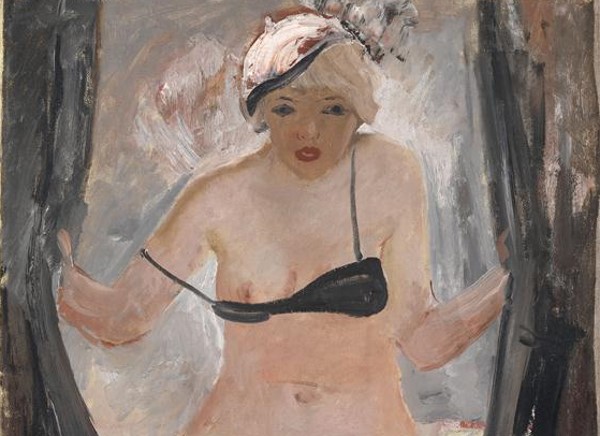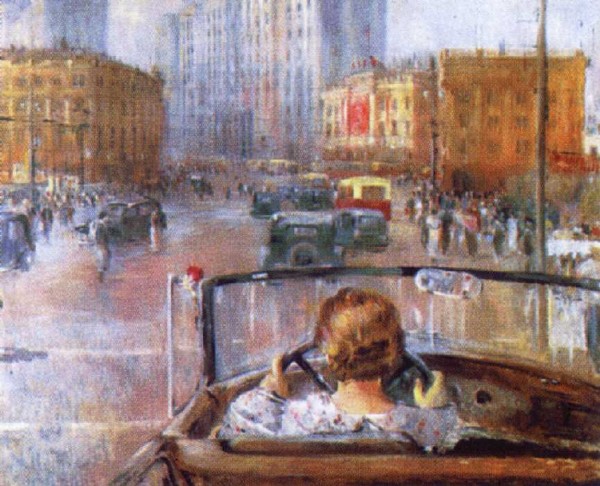
Russian Art "Behind the Curtain" of History
/ Главная / Russkiy Mir Foundation / Publications / Russian Art "Behind the Curtain" of HistoryRussian Art "Behind the Curtain" of History
12 October 2015 saw a rather big event in the history of Soviet art sales—Aleksandr Deineka’s painting Behind the Curtain was sold at the MacDougall's auction house in London for 2,248,000 pounds (3,500,000 dollars). It proves there has been a surge in interest for Soviet art, insiders say.
This sum could buy three perfectly good houses in New York City or two-and-a-half similar houses in London. Why did the anonymous buyer pay so much for the masterpiece? Art dealers argue the reason is quite simple, since instead of going the traditional path of “Soviet dolce vita” Deineka went “behind the curtain” to show something far outside the outline of his work.

The painting depicts a nude female figure, supposedly a woman of easy virtue. Finished in 1933, it was presented by the government award-winning artist to his peer Fyodor Bogorodsky, also a Social Realist painter. The picture later fell into the hands of a European collector who decided to sell it—and on very beneficial terms, judging by the price.
What is particularly impressive about it is not this local success story but the overall pricing trend with regard to Soviet art. In the early 1990s artworks by Deineka and other artists of the Stalin era could be purchased for tens of thousands of dollars (sometimes even less), while post-Stalin art could cost less than 10,000 dollars. Today even typical artworks by Deineka's contemporary, Soviet Impressionist Yuri Pimenov, let alone rare paintings by Deineka himself, can be sold at more than one million—dollars or pounds.
However, works by other Social Realists were sold at much more “relaxed” prices at the auction. For instance, Letter from the Front painted by Konstantin Korovin’s apprentice Nikolai Terpsikhorov in 1947 was sold for 111,000 GBP, Lotuses by Konstantin Maksimov for 251,000 GBP and Girl on the Balcony by Alexander Labas for 100,000 GBP. The latest auction brought in 3.9 million GBP in total, which MacDougall’s considered a resounding success.

This British auction house was founded by husband and wife William and Catherine MacDougalls. William is a Russian-born Scotsman and his wife Catherine (Ekaterina) is Russian. After managing securities for several years, the couple started collecting Russian art, just for themselves. When it took off, they decided to open an auction house. Today MacDougall's is the third-largest Russian art auction house.
Art collector Andrei Filatov, one of those people who prefer to purposefully invest into Soviet art, says that “the romanticism of Soviet revolutionaries can be much more profitable than works by such masters as Pablo Picasso or Paul Gauguin.”
Of course, modern Russians would rather feast their eyes on paintings like New Moscow by Yuri Pimenov—it is nice to see one’s native city, and not Paris or Nice, glow with rainbow colors. Among those who share this view is banker Alexei Ananiev who opened his own museum in 2011. The Institute of Russian Realist Art has about 500 realist artworks on display.
Recently another big deal was closed: Russian businessman Sergei Skatershchikov, Skate Capital founder, bought ARTnews, one of the oldest and most influential visual arts magazines—a very forward-thinking move for a long-term impact on the art market.
Meanwhile, the MacDougall’s auction house has decided to add mid-season sales to its summer and winter auctions. Some business analysts consider it proof of the auction house's success. Director of the auction house Catherine MacDougall thinks that this is a necessity: “If you only sell Russian art twice a year, buyers may forget about it.”

However, New York art dealer and collector Gregory Vinitsky offered a different take on the situation in our exclusive interview: “A random Deineka buy does not mean much about the market situation. One could trace how many lots they sold. This auction was oriented towards a certain group of people—commercial art buyers. MacDougall’s organizes mid-season sales to compensate for the fall in prices, as they are in dire need of boosting the sales level or at least keeping it firm.”
It is well known that the prices for Russian art experienced a decline in 2011 and never recovered despite all attempts of numerous auction houses and private art dealers. When opposed with low prices, most art owners do not want to sell the most valuable items in their collections. As a result, the Russian art market does not see truly valuable works of art very often, prompting the few serious collectors to invest in them.
Of course, there is a demand for artists of the Stalin era. One cannot judge the overall market situation by one Deineka that brought in 60 per cent of the auction profit. But let us be optimistic in the spirit of Social realism and look forward to the bright future when Russian art will no longer have to shyly hide behind the curtain.
New publications

 Mikhail Kalatozov, a director who transformed the world of cinematography in many ways, was born 120 years ago. He was a Soviet film official and a propagandist. Above all, he was capable of producing movies that struck viewers with their power and poetic language.
Mikhail Kalatozov, a director who transformed the world of cinematography in many ways, was born 120 years ago. He was a Soviet film official and a propagandist. Above all, he was capable of producing movies that struck viewers with their power and poetic language.  Ukrainian authorities have launched a persecution campaign against the canonical Ukrainian Orthodox Church (UOC), the biggest one in the country's modern history. Over the past year, state sanctions were imposed on clergy representatives, searches were conducted in churches, clergymen were arrested, criminal cases were initiated, the activity of the UOC was banned in various regions of the country, and monasteries and churches were seized.
Ukrainian authorities have launched a persecution campaign against the canonical Ukrainian Orthodox Church (UOC), the biggest one in the country's modern history. Over the past year, state sanctions were imposed on clergy representatives, searches were conducted in churches, clergymen were arrested, criminal cases were initiated, the activity of the UOC was banned in various regions of the country, and monasteries and churches were seized.  When Nektary Kotlyaroff, a fourth-generation Russian Australian and founder of the Russian Orthodox Choir in Sydney, first visited Russia, the first person he spoke to was a cab driver at the airport. Having heard that Nektariy's ancestors left Russia more than 100 years ago, the driver was astonished, "How come you haven't forgotten the Russian language?" Nektary Kotlyaroff repeated his answer in an interview with the Russkiy Mir. His affinity to the Orthodox Church (many of his ancestors and relatives were priests) and the traditions of a large Russian family brought from Russia helped him to preserve the Russian language.
When Nektary Kotlyaroff, a fourth-generation Russian Australian and founder of the Russian Orthodox Choir in Sydney, first visited Russia, the first person he spoke to was a cab driver at the airport. Having heard that Nektariy's ancestors left Russia more than 100 years ago, the driver was astonished, "How come you haven't forgotten the Russian language?" Nektary Kotlyaroff repeated his answer in an interview with the Russkiy Mir. His affinity to the Orthodox Church (many of his ancestors and relatives were priests) and the traditions of a large Russian family brought from Russia helped him to preserve the Russian language.

 The leaders of the Friends of the Great Russia cultural association (Amici Della Grande Russia) in Italy believe that the Western policy of abolishing Russian culture in Europe has finally failed. Furthermore, it was doomed to failure from the beginning.
The leaders of the Friends of the Great Russia cultural association (Amici Della Grande Russia) in Italy believe that the Western policy of abolishing Russian culture in Europe has finally failed. Furthermore, it was doomed to failure from the beginning.  Name of Vladimir Nemirovich-Danchenko is inscribed in the history of Russian theater along with Konstantin Stanislavski, the other founding father of the Moscow Art Theater. Nevertheless, Mr. Nemirovich-Danchenko was a renowned writer, playwright, and theater teacher even before their famous meeting in the Slavic Bazaar restaurant. Furthermore, it was Mr. Nemirovich-Danchenko who came up with the idea of establishing a new "people's" theater believing that the theater could become a "department of public education."
Name of Vladimir Nemirovich-Danchenko is inscribed in the history of Russian theater along with Konstantin Stanislavski, the other founding father of the Moscow Art Theater. Nevertheless, Mr. Nemirovich-Danchenko was a renowned writer, playwright, and theater teacher even before their famous meeting in the Slavic Bazaar restaurant. Furthermore, it was Mr. Nemirovich-Danchenko who came up with the idea of establishing a new "people's" theater believing that the theater could become a "department of public education."  "Russia is a thing of which the intellect cannot conceive..." by Fyodor Tyutchev are famous among Russians at least. December marks the 220th anniversary of the poet's birth. Yet, he never considered poetry to be his life's mission and was preoccupied with matters of a global scale. Mr.Tyutchev fought his war focusing on relations between Russia and the West, the origins of mutual misunderstanding, and the origins of Russophobia. When you read his works today, it feels as though he saw things coming in a crystal ball...
"Russia is a thing of which the intellect cannot conceive..." by Fyodor Tyutchev are famous among Russians at least. December marks the 220th anniversary of the poet's birth. Yet, he never considered poetry to be his life's mission and was preoccupied with matters of a global scale. Mr.Tyutchev fought his war focusing on relations between Russia and the West, the origins of mutual misunderstanding, and the origins of Russophobia. When you read his works today, it feels as though he saw things coming in a crystal ball...